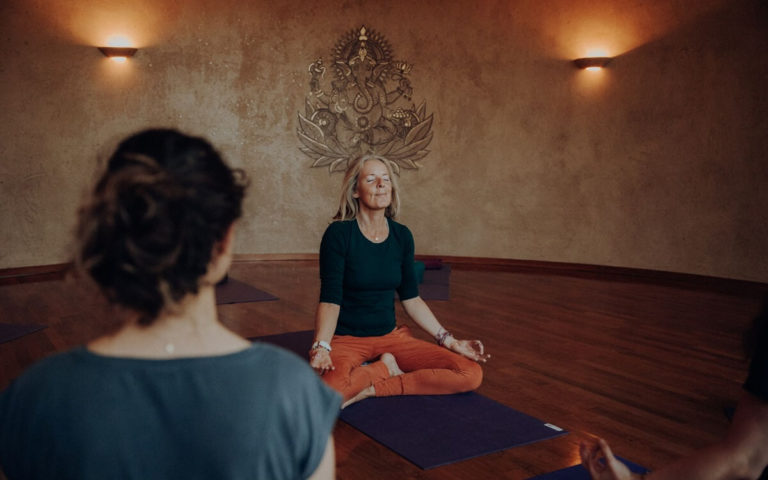Ayurvedic teachings assume that physical and mental complaints arise from an imbalance. The three doshas, which have a significant influence on mental balance, form the basis for individual healing approaches and treatments. In this article, you can find out how the Indian art of healing works in harmony with body and mind.
What is Ayurveda actually?
The Sanskrit word "Ayurveda" is made up of the words "Ayus" for life or long life span and "Veda" for knowledge or science. The term can therefore be translated as "science of (long) life".
Ayurveda as an art of healing has existed for thousands of years as a health system of the ancient Indian Vedic civilization. It is therefore one of the oldest existing healing arts in the world and is also recognized as traditional medicine by the WHO.
Ayurveda as a holistic health science
The word part "Veda" describes the comprehensive teaching that views man, nature and the cosmos as a whole. The holistic health teachings therefore encompass life as a whole and combine physical, psychological, mental and spiritual aspects. The aim is to achieve a balance between body, mind and soul.
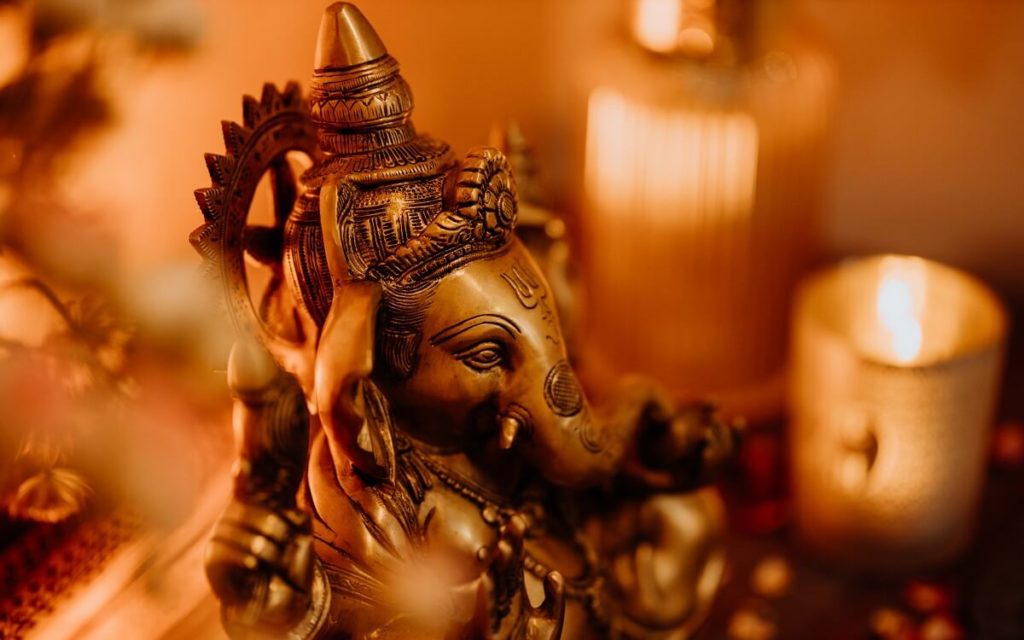

Only a person who is in balance can sustainably prevent illness and - if necessary - cure it with Ayurveda. When choosing your treatment, the Ayurveda experts take key aspects of your life into account. This includes your awareness, your diet and exercise or even current medications.
What does Ayurveda help with?
Ayurveda can prevent illness and alleviate existing complaints by activating the body's self-healing powers. Ayurvedic treatments are particularly suitable for reducing stress and restoring balance.
For example, Ayurveda can alleviate symptoms of osteoarthritis or you can reduce excess weight with an Ayurvedic diet. Skin diseases, joint problems, back pain, digestive disorders, migraines and sleep disorders can also be treated with Ayurveda. It can help to bring the body and mind back into balance.
The three constitutional types in Ayurveda
Your doshas, which represent your "basic functional principle", play an essential role in the creation of your Ayurveda cure. According to Ayurvedic teachings, they control all processes and functions of the human body.
You can find out which constitution type you are in our Dosha test. This will tell you how pronounced Vata, Pitta and Kapha are in you. They determine the nature around you as well as your body and mind. With an Ayurvedic lifestyle, you can keep the three basic energies in balance and create the best conditions for health and satisfaction.
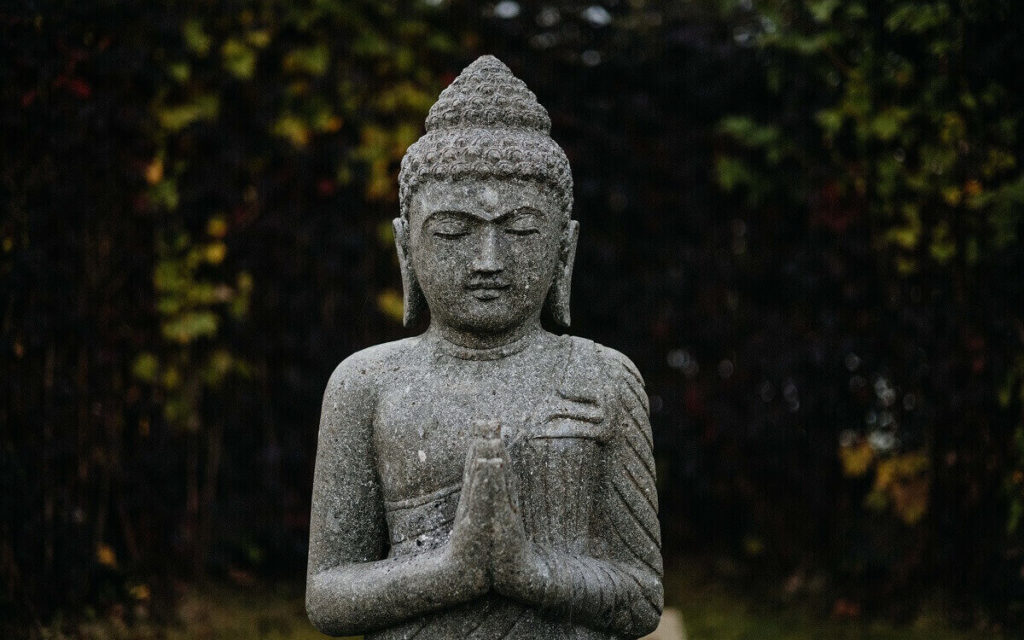

According to the Ayurvedic view of the individual uniqueness of each person, specific characteristics and physical features indicate a certain dosha distribution. The weighting of the doshas is innate and hardly changes in the course of life.
Overview of the three doshas
| Vata: The principle of movement | Pitta: The metabolic principle | Kapha: The structural principle | |
| Elements | Ether, air, space | Fire, water | Earth, water |
| Typical properties | Flexible, fast, light, cool/cold, dry, changeable | Warm/hot, reddened, sharp, irritated | Immobile, heavy, moist, slow, firm, stable |
| Body stature | Rather light physique with low weight | Mostly medium build | Rather stable, heavy build |
| Typical strengths | Quick perception, enthusiastic, clear, alert mind, creativity | Satisfaction, sharp intellect, eloquent | Persevering, strong, calm |
| Digestion | Rather irregular, this also applies to hunger, tendency to constipation and flatulence | Pronounced hunger, good digestion, can skip meals badly, active metabolism, tendency to soft stools, sometimes diarrhea | Less appetite, slow digestion, gains weight easily |
The Vata type
As a Vata type, you are by nature a delicate and sensitive person with a slender build, dry skin and artistic and sensitive abilities. In Ayurveda, Vata represents the principle of movement and is characterized by speed, instability and a multi-faceted personality. The Vata constitution type has many interests and talents, is physically and mentally active, curious and has the urge to move.
The Vata type has a very sensitive digestion and an irregular appetite. It reacts to stress, poor diet and inner tension with a bloated stomach and constipation. The nervous system is also one of the sensitive aspects of Vata. Its physical strength and resistance to illness is rather low. The Vata type is particularly affected by cold and wind.
The greatest strength of this type is its ability to communicate. With this dosha type, you have an open nature, make new contacts easily and are generally talkative. Your contingent of ideas and creativity knows no bounds. You take on new tasks with enthusiasm. On the other hand, your stamina is rather low and you often pursue several projects at the same time without being able to concentrate fully on one.
The resulting overload also protects you from boredom and routine. As a Vata type, you are more prone to mental and psychosomatic illnesses. Your musculoskeletal system is susceptible to digestive disorders and complaints, anxiety, sleep disorders, exhaustion and tinnitus.
The Pitta type
As a Pitta type, you have a dynamic, successful and impressive personality. Your energy potential as well as your physical and mental abilities are extraordinarily powerful. Pitta is fiery and provides you with heat, spiciness and acidity, which has a positive effect on your digestion and metabolism.
You are enthusiastic about exercise and use physical exertion as a relaxing balance for your often tense mind. Pitta's strengths include good reasoning skills, which you translate into fluent, clear speech. Pitta people are good speakers and take a special position in discussions or conversations.
Pitta is often dominant, assertive and particularly capable of taking action. Pitta is characterized by heavy sweating and warm, well-perfused skin as well as skin complaints, hyperacidity, inflammation and problems with the liver and other digestive organs.
The Kapha type
Your inner strength and stability characterize you as a Kapha type. You are strongly built and have a resistant immune system. You are calm and composed in your dealings with others and yourself. The watery and earthy principle of Kapha offers you slowness, security and contentment as well as a tolerant personality.
The Kapha type has a well-developed body with rounded contours and tends to be overweight despite low food intake. Kapha people usually have beautiful, smooth skin and large, expressive eyes as well as thick hair. They have remarkable physical strength and are resistant to disease.
Typical Kapha diseases include diabetes, lung, bronchial and sinus complaints. Kapha types are also prone to obesity and related illnesses.
Of all constitutional types, Kapha dosha has the lowest tendency to mental disturbances and has a calm, balanced and loyal nature. At the same time, Kapha tends towards comfort and inner phlegm. This type is also characterized by low physical and mental energy and often needs a lot of time for itself and its tasks.
The mixed types and Tri-Dosha
Hardly anyone is a pure dosha, but rather a mixed type. In most cases, two doshas are more pronounced, while the third is weaker. It is very rare to find all three doshas in a balanced ratio, which is referred to as a tri-dosha in Ayurveda. Knowing the proportions of your dosha types helps you to better understand your body, your moods and your characteristics.
6 Central elements of Ayurveda
Ayurvedic teachings are made up of various elements that have the common goal of keeping your body, mind and soul healthy in the long term. The different methods and applications for treating your ailments are always tailored to your individual needs.
1. pulse diagnosis
The first element of an Ayurvedic treatment is the anamnesis to determine your problem areas. Pulse diagnosis is a classic component of Ayurvedic treatment, in which your pulse is palpated with three fingers.


Based on the system of your pulse, the Ayurveda expert receives important information about possible disorders. An imbalance of the doshas can also be identified through pulse diagnosis.
Our professional pulse diagnosticians will immediately assess you as a whole, enabling a more precise diagnosis. If an imbalance in the interaction of your doshas is detected, Ayurveda offers a wide range of measures to restore your natural balance.
2. massages
Ayurveda offers a variety of different forms of massage with different applications and effects.


- Abhyanga is a gentle full-body massage with special oils, which is usually performed by two treating experts in sync. The massage helps to balance your doshas and is both cleansing and relaxing. Essences tailored to your constitutional type support the massage treatment.
- Vishesh is a particularly intensive form of synchronized full-body oil massage. The massage is significantly stronger than Abhyanga and is often used as part of a deep cleansing treatment.
- Garshan is a popular dry massage in Ayurveda. Your entire body is massaged with a special silk glove, completely without oil. This treatment primarily balances Kapha, while Vata and Pitta are stimulated and increased.
- Udvartana is a special full-body massage and causes deep tissue detoxification and purification. Udvartana is an effective treatment for metabolic disorders in particular. The stimulating massage is performed with Ayurvedic powders and stimulates blood circulation and smoothes the skin.
- Pinda Sweda is an Ayurvedic massage with herbal pouches. The spice-filled cloth pouches are a very effective, universal and versatile therapeutic tool, depending on the ailment. The herbs are often mixed with cooked rice and used as a warm application.
3. (Cleansing) cures
An important element of Ayurveda treatment is cleansing the body with Ayurvedic cleansing treatments. This removes metabolic residues and harmful substances from your body. It also counteracts the excessive accumulation of waste products, known as ama in Ayurveda.
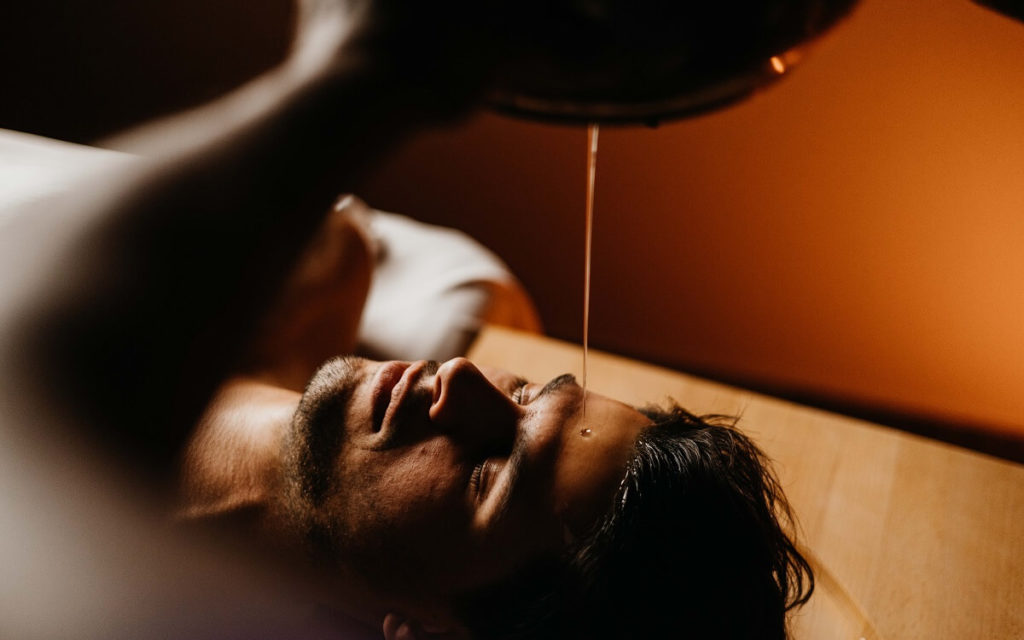

One of the most important Ayurvedic therapies for internal cleansing is the Panchakarma cure. The cure can be translated as "five actions" and consists of intensive external and gentle internal cleansing. Whole-body massages, forehead irrigations and steam baths as well as enemas are part of the treatment.
The aim of this Ayurvedic treatment is to gently free your body of toxins and metabolic waste. This also restores the harmonious balance of your body and your constitutional types. Panchakarma is carried out both to treat and prevent illnesses and to increase well-being.
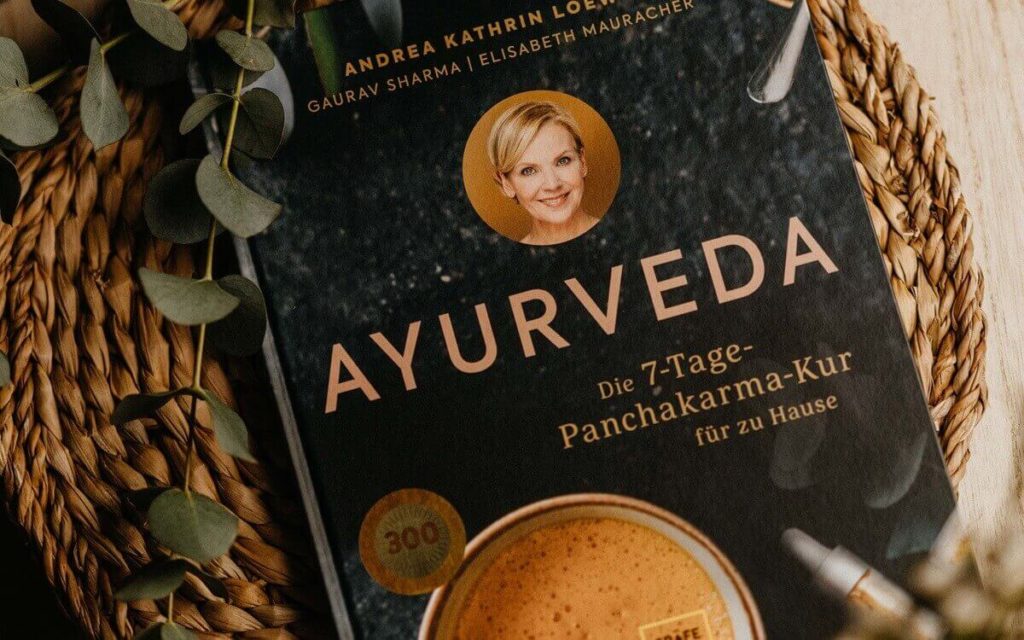

Discover the Panchakarma cure for at home
In our book "Ayurveda: The 7-day Panchakarma cure for at home", our experts show you how you can gently detoxify in 7 days.
4. nutrition
The right diet plays an important role in Ayurvedic teachings and is ideally tailored to the composition of your doshas. Ayurvedic nutrition is used for both health maintenance and healing purposes . For this reason, there are also certain rules regarding eating habits.
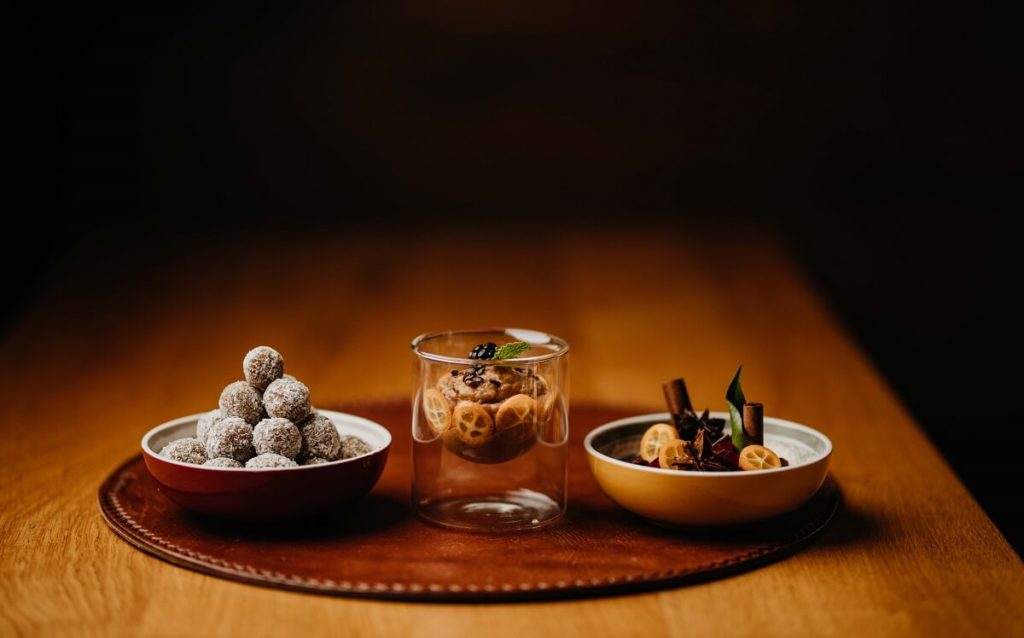

It is not only what you eat that is important, but also how well you digest your food. The prerequisite for this is a healthy digestive fire - called Agni in Ayurveda - which regulates and influences the entire metabolism. A healthy diet is also associated with the development of ojas, which is closely linked to life energy.
According to Ayurvedic teachings, every food has certain properties that you can use to improve and balance your doshas. It is therefore all the more important that you eat a dosha-appropriate diet in order to get the best possible benefit.
Diet alone can prevent illness and delay the ageing process. The following points are part of Ayurvedic nutrition:
- Only eat when you are really hungry
- Stick to fixed meal times
- Eat in a relaxed atmosphere and without stress
- Make sure you eat at the right pace and avoid gorging
- Prepare your food fresh
- Prefer cooked food
- Give your food the right seasoning
- Drink mainly warm drinks and in small sips with your meal
- Eat a Dosha-friendly diet
- Use Ayurvedic food supplements to better balance your doshas
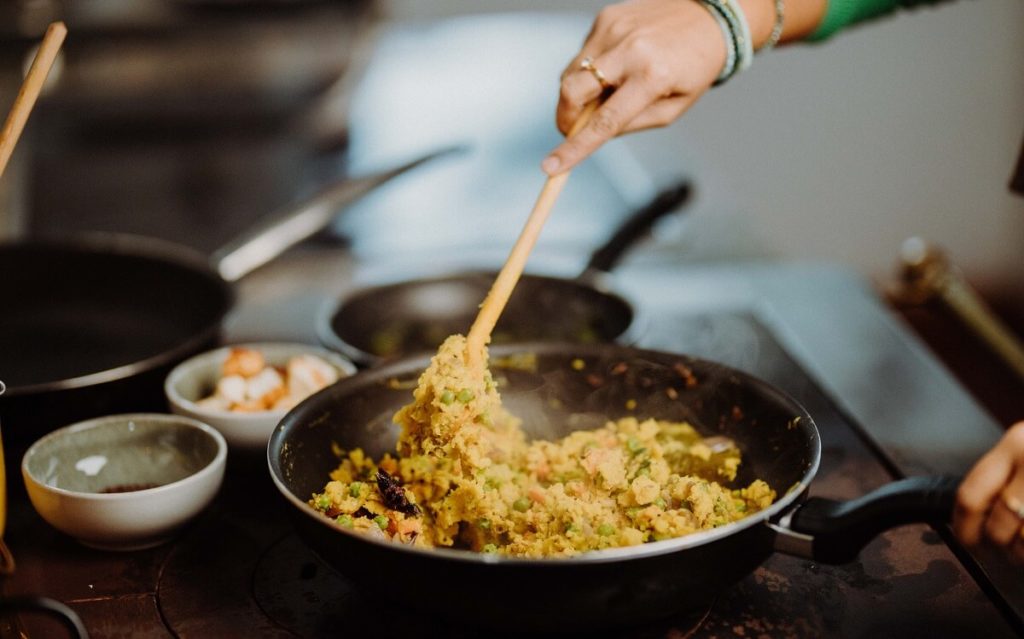

The following overview shows you which foods are particularly recommended for the individual constitution types:
| Vata | Pitta | Kapha | |
| Cereals | Wheat, rice, cooked oatmeal | Wheat, rice, barley, millet, maize, oat flakes | Stored cereals, barley, millet, maize, buckwheat, rye, oat flakes, wheat, rice |
| Legumes | Yellow mung beans, red lentils | Soy products, yellow mung dal | All bean varieties |
| Vegetables | Zucchinis, artichokes, asparagus, sweet potato, cucumber, celery, spinach (in small quantities) | Asparagus, artichokes, white pumpkin, zucchinis, okra, spinach, chicory, cauliflower, broccoli, cabbage, celery, potatoes, sweet potatoes, sprouts, lettuce, young eggplants | Green leafy vegetables, asparagus, artichokes, potatoes, carrots, cabbage, cauliflower, broccoli, celery, peas, peppers, sprouts, zucchinis, tomatoes, young radish |
| Fruits | Ripe, sweet and juicy fruit, grapes, pomegranates, mangoes, bananas, avocados, sweet and juicy apples and pears, sweet oranges, melons, plums, raisins, dates, prunes, figs, kiwis, peaches, apricots, dried fruit is best soaked. | Grapes, pomegranates, bananas, avocados, mangoes, melons, apples, pears, raisins, dates, figs, apricots, sweet oranges, grapefruit, olives, sweet pineapple, papaya (in small quantities), kiwis | Pomegranates, grapes, cranberries, raisins, figs, dates, peaches, apples, papaya |
| Dairy products, oils and other | All dairy products, sugar cane, honey (in small quantities), all good oils, all nuts | Ghee, milk, butter, lassi (sweet), cream, coconut oil, olive oil, coconut | Lass, buttermilk, ghee, whole milk (in small quantities), honey, sunflower seeds, pumpkin seeds, cashew nuts, all spices except salt, lemon juice (in small quantities) |
Foods that you should avoid depending on your constitutional type are:
| Vata | Pitta | Kapha | |
| Flavor | Pungent, bitter, tart | Strongly spiced, hot, sour, salty | Sweet, sour, salty |
| Food | Cold foods and drinks, dry foods, beans (except mung beans and red lentils), unripe, dry and sour fruits | Sour fruit, tomatoes, sour milk products, yoghurt (only as lassi), quark, cheese | Whole milk, ghee, fatty and oily foods, ice cream, sweets |
5. yoga & meditation
Ayurveda and yoga go hand in hand. Meditative yoga practice is an integral part of the Ayurvedic art of healing and focuses on inner and outer cleansing. With yoga and meditation exercises, you learn to free yourself from mental baggage and let go internally. By meditating, you practise mindfulness and awareness of yourself and your environment.


This makes it easier for you to free yourself from stressful thoughts and concentrate fully on the here and now. Regular meditation therefore promotes your health on many levels. Yoga and meditation are also helpful for chronic pain, psychological complaints and sleep disorders.
Yoga is a wonderful way to achieve more balance in everyday life and helps you to become more aware of your body. At the same time, yoga gives you more strength and flexibility, which has health benefits. Yoga has been shown to lower blood pressure, help with back pain and headaches, reduce nervousness and anxiety and improve sleep quality.
6. herbal medicine
Herbal medicine is an important part of Ayurvedic medicine. Plants have always been used as part of therapy and treatment. Over thousands of years, the knowledge of how to release the healing powers of plants has been preserved. This includes the selection and composition of the plants, the right time to harvest, purification and processing.


There are special recipes that affect the function of your organs or doshas, for example. Ayurvedic medicine also includes recipes that have a health-promoting, strengthening or rejuvenating effect. Finally, Ayurvedic food supplements have also developed from these properties to further strengthen your body.
European Ayurveda® - Ayurvedic tradition meets European needs
Ayurveda is a holistic health theory from the ancient Indian Vedic civilization. It is based on the three doshas, which should be brought into harmony. The focus is on the individual body, mind and soul as a unit. The central elements of Ayurveda are pulse diagnosis, massages, (cleansing) cures, yoga & meditation, Ayurvedic nutrition and herbal medicine.
At Sonnhof, we try to combine the traditional teachings of Indian Ayurveda with the needs of Europeans. We focus less on the body and more on the mind, as emotional stress plays a major role here. This is how European Ayurveda® came about. Experience European Ayurveda up close at Sonnhof Tirol!


What is European Ayurveda®?
Ayurveda is an Indian art of healing with a long tradition. Translated, the term means "knowledge of life". But life looks very different in different cultures.
Over the first few years, we slowly realized that the needs of Indians and Europeans differ. This is how we finally developed the concept of European Ayurveda®.



